Flashback: Volkswagen Type 166



























|

|

|

|

|

|

|

|

|

|

|

|

|
Believed to be amongst only 150 remaining ‘Schwimmwagens’ in the world this local vehicle is amongst the finest examples
From Unique Cars #285, Apr/May 2008
VW Type 166
You don’t have to be a wide-eyed military buff to appreciate this Army-spec amphibious vehicle. Cars that are as comfortable on water as they are on land are fascinating at best but Volkswagen’s Type 166 from World War II is just so different.
This rugged German vehicle is an acquired taste for most collectors but for someone fascinated by all things VeeDub it is perhaps the ‘piece de resistance’, especially given the fact it was designed by Ferdinand Porsche.
Exceedingly rare today it was built with one single ambition – to be used by the Third Reich for its planned invasion of Russia.
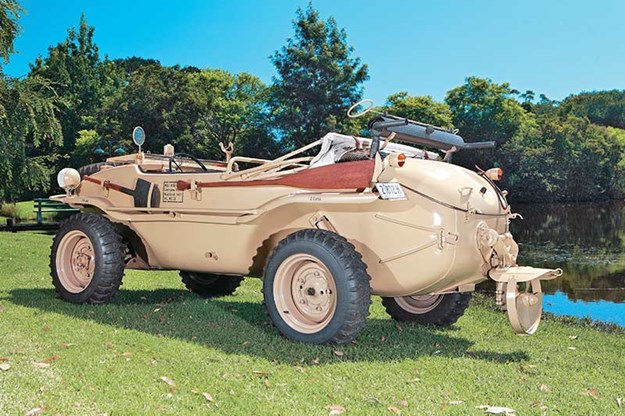
In effect the German SS had given Porsche a brief to design a vehicle that could travel with four soldiers over any kind of terrain through slime, snow and mud. But not only was it to have a cross-country capability it would also be required to traverse rivers and carry out reconnaissance by water – a lightweight go-anywhere vehicle, in other words.
The Type 166 – nicknamed Schwimmwagen or swimming car – was a re-design of Porsche’s larger Type 128 designed in 1940 which had shown itself to be unstable and limited in off-road ability.
The Type 128 was based on the same long wheelbase as Porsche’s military-style road going four-wheel drive Kubelwagen and it was soon found to lack torsional rigidity. Early testing in very rough terrain had produced ruptures in the custom welded body tub, especially at the front cross member and in the wheel wells.

Front wheels act as rudders under water
The lighter Type 166 with a wheelbase of 2000mm was 400mm shorter and 100mm narrower and early prototypes were constructed by Porsche using the flat platform chassis of the civilian VW Beetle. However, he quickly discovered that the Beetle’s flat floor pan was unsuitable for an amphibious vehicle and developed an all-new unitised body tub structure.
Porsche began the design of the Schwimmwagen in March 1941 and by August the first prototype was ready for evaluation. In his son Ferry’s book We at Porsche, Ferdinand recalls how he was asked to bring the new vehicle to Hitler’s headquarters for a demonstration.
"He took a long time inspecting the vehicle and asked the most detailed questions. His manner was then quite informal and he just said whatever came into his mind…‘I would like you, by the way, to think over one serious problem. It concerns our soldiers in the East. They constantly have to fight off swarms of mosquitoes as well as the Russians. Could you devise some kind of mosquito net for this car that would give them protection while in transit?’" Porsche was highly respected by the Fuhrer but one can only imagine what the brilliant car designer thought of this suggestion.
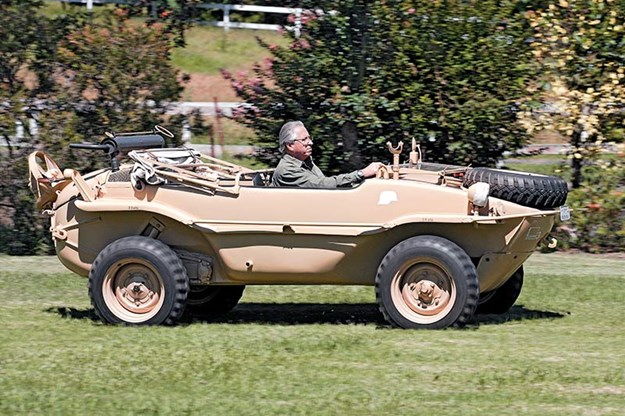
Bath-tub shape and high-mounted exhausts aid amphibious usage
The Germany Army (Wehrmacht) finally gave approval for the Type 166 in March 1942. After the initial batch of 125 was built at Porsche’s Stuttgart facility volume production started in earnest at a new factory in a new town called Fallersleben, later renamed Wolfsburg. Here, some 14,276 Schwimmwagen were built before severe allied bombing put an end to production late in 1944. A further 1308 of the Type 166 were built by Porsche in Stuttgart.
Such was the success of the 166 that they were soon in demand by the regular German army units, perhaps more for their all-terrain ability rather than for their amphibious design.
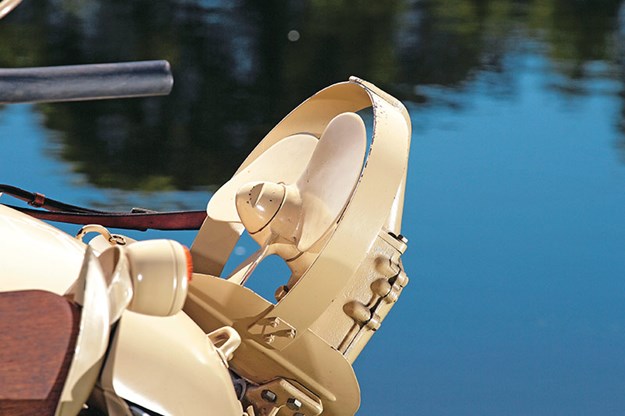
Rear-mounted propeller in ‘swimming’ position
Today, less than 150 are believed to have survived worldwide while just three are known in Australia. Such was the attrition rate in Russia that around 80 percent of the invading 166s did not return. At the height of the conflict the average life span of a Schwimmwagen was said to be just three to six weeks.
Post war many found service in a variety of roles as Europe struggled to get back on wheels. Given their versatility many found a new recreational use; some even found favour with the duck shooting fraternity.
The 1944 example featured here was imported into Australia from Europe in the late-1980s. It was subsequently purchased by a NSW-based Volkswagen enthusiast in 1994 who undertook a very sympathetic restoration on what he describes as "a highly original example".
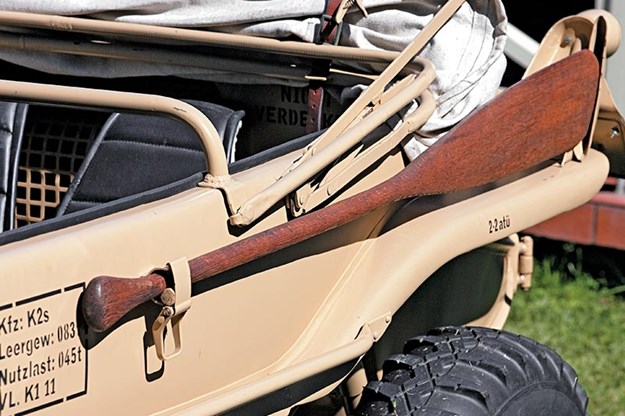
Original wooden paddle found at swap meet
After removing up to six coats of paint the object was to bring it back to its full military attire. The Type 166 was mainly painted ‘panzergrau’, a greenish-grey camouflage or beige as per this example.
Missing were the special shovel, wooden paddle and machine gun mounts, but a chance discovery at a military swap meet in late-1994, part of the 50th anniversary commemoration of the allied landing at Normandy, produced an original oak shovel and paddle at very minimal cost.
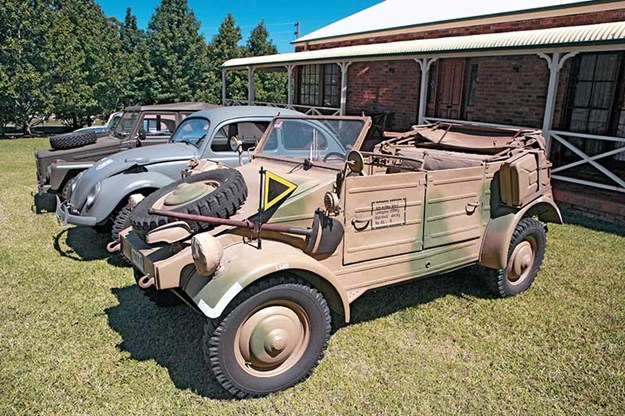
Whilst the owner has an original de-commissioned German MG34 machine gun, which was standard equipment with the 166, he prefers not to make a feature of it. However, when fitted this 1000-round-per-minute weapon gives this military vehicle a lot more character.
Originality was the keynote in the vehicle’s refurbishment and a recent German visitor, a recognised 166 authority, believes it to be now one of the 10 best examples in the world.
The Type 166 actually used the more powerful 1131cc flat-four VW boxer engine from day one, which would later be fitted to all Volkswagens produced from March 1943. The rear-mounted engine links to a four-speed no-synchromesh gearbox with reverse – a two-speed transfer case providing four forward gears in both two and four-wheel drive.
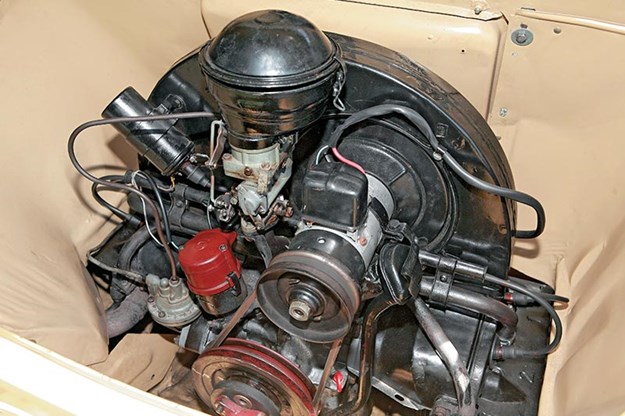
1131cc VW ‘boxer’ engine can propel Type 166 to 85km/h on dry land
On the open road it will comfortably cruise along at around 85km/h, is light of control and with a low set drivetrain feels to have a very low centre of gravity. An extra low crawling gear provides exceptional climbing ability in four-wheel-drive but progress is nevertheless slow.
The engine is well encased in its own compartment with access via a water- tight panel on top. It’s easy to get at and well protected with the body side at the rear well above water level.
The body tub floor is divided into compartments for strength and obviously contains any leakage or wash. Wooden duckboards provide the driver and passenger with somewhere to put their feet but otherwise all aspects of the interior are workmanlike and spartan.
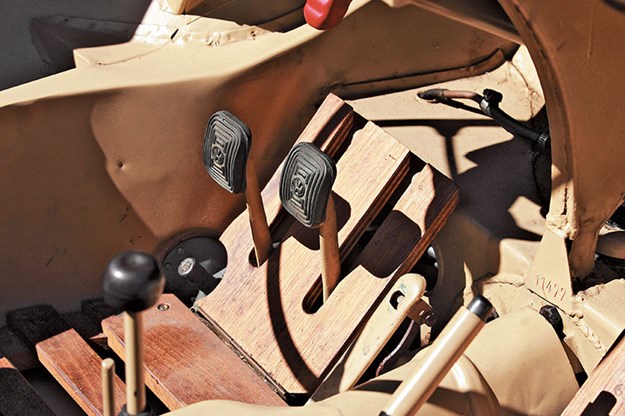
Duckboards help keep feet dry
The seats are simple tubular frames with minimal padding while a very flimsy folding tubular frame hood was provided but both probably offered little comfort on the way to the Russian front.
Ventilation to the engine is provided by an intake grille high up at the rear of the body between the rear seats while a long transverse-mounted and perforated exhaust pipe gets rid of the exhaust gases.
Approaching a water crossing is relatively simple – the rear-mounted three-bladed propeller fitted with a protective shroud is held up at the rear by a leather strap and simply swings down and locks into position with the help of a spring. Once in the water the rear passenger can lower or raise the propeller drive with a long hook device.
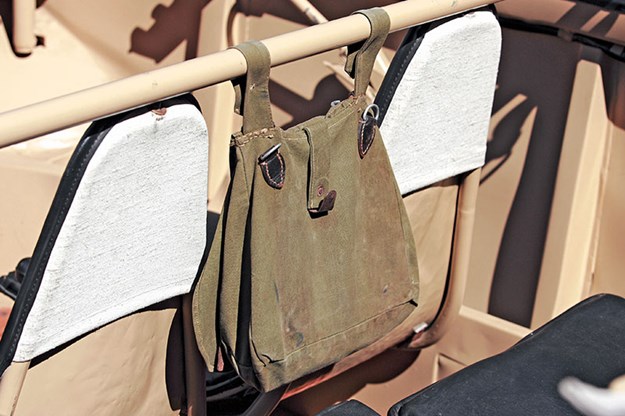
Propulsion is provided by a direct coupling via drive dogs off the end of the crankshaft – simple and very effective.
Certainly the layout of the VW flat-four mechanical design was perfect for its application in the Type 166. The whole package reflects the clever innovation that has become the hallmark of Porsche design.
Screw propulsion in water is only available going forward with a maximum speed of around 10km/h. To reverse you select land-based rear-wheel-drive and allow the tyres to act as frictional propellers. Steering in the water is also affected by the front wheels acting as rudders.

The wooden paddle strapped to the side is obviously a handy standby but probably better suited to stealth-like manoeuvres rather than providing too much forward motion.
The mudguards are simple horizontal structures that appear high up when it’s out of the water but they obviously provide a plimsol line and some stability once the vehicle is floating.
However, sitting relatively low in the water the wash from another vessel could easily unsettle the Schwimmwagen, especially with a full compliment of passengers on board providing a higher centre of gravity. An 11-gallon fuel tank mounted up-front and split in two with dual fillers obviously balances the effect of the rear-mounted engine.
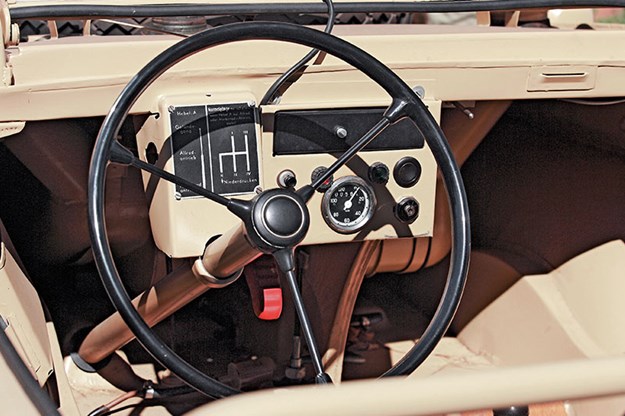
From the back the swing-axle design of the Beetle is more than evident. Gear reduction boxes at each wheel reduce driveline stresses but cleverly provide better ground clearance in the process, a system that owes its origins to the land-based Kubelwagen.
Braking is provided by cables acting on all four wheels while a handbrake is also connected to the same system.
Porsche very cleverly kept penetrations of the tub structure to a minimum for obvious reasons. Interestingly, while the Schwimmwagen was assembled in Fallersleben the boat-like tub structures were actually manufactured in Berlin by the American-owned Ambi-Budd company, adding a touch of intrigue.
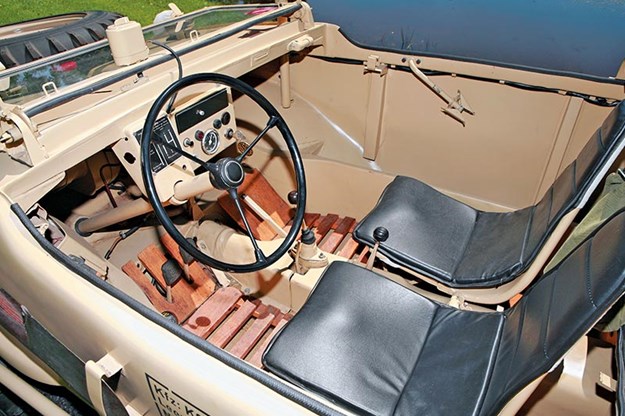
Utilitarian cabin belies military heritage
The independent VW front suspension is mounted on stiffening brackets which form part of the tub structure and their long-travel nature was perfect for this all-terrain vehicle. The vehicle here is fitted with the 16x7inch rims shod with rugged 6.00x16 chevron-pattern Continental balloon tyres which obviously aid buoyancy.
One innovation designed by Porsche is a central oiling system via a lever and 1.0-litre container located under the instrument panel. This both lubricates and cleverly forces water from moving parts once you return to dry land.
Whilst I was disappointed I wasn’t able to test its ‘schwimming’ ability, its reputation in the water is very well documented especially in war-time photography. In fact its owner has enjoyed its aquatic abilities only once – as he says "this vehicle is too rare today to chance losing it in the water".

However, this fascinating vehicle is just one of a number of rare Volkswagens that make up his collection including an equally well-preserved 1944 Type 82 Kubelwagen and a later 1971 NATO Type 182 Kubel.
On top of that he has an extensive collection of early Beetles including a rare 1952 split rear-window model and an early ’53 model, one of the very first cars with the oval rear window, still sporting its original vinyl trim.
But it’s the 166 – with its rear-mounted propeller and ‘optional’ MG34 machine gun – that really fires the imagination.
In the line of fire
Australia has its own rich history of military vehicles, including this very rare, genuine and now pristine Australian Army 48-215 ute, part of the collection of early Holden restorer Phil Munday.
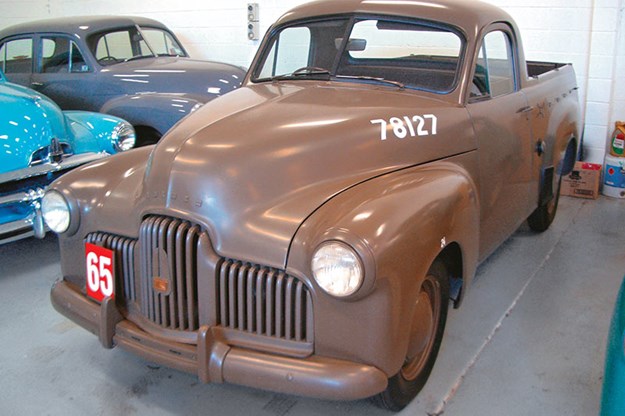
Munday says the car carries build-number 73 and was part of an initial batch of 100, which are identified by their unique Khaki paintwork. Later versions were finished in Deep Olive Bronze.
He discovered the decaying ute on a farm at Stawell in Victoria’s west. "It nearly fell in half when we raised it with a forklift," Munday said. "The back of the roof was the only thing holding it together. Everything was basically buggered.
"I wondered if it was worth the effort but I was spurred on because it is such a rare vehicle and all the original unique fittings were still there," he said.
Those features include a log book holder mounted on the driver’s side kick panel, holes in the quarter panels for the canvas canopy, rear bumperettes, metal sleeves for the battalion number sign, original markings and a drip tray located over the front windscreen.
"I believe the drip tray was there in case the windscreen broke or was shot out," said Phil. The car also features a distinct lack of chrome.
Munday, who operates Phil Munday’s Panel Works in the Melbourne suburb of Kilsyth, brought the living piece of Australian history back to life at another of his businesses, Kilsyth Automotive Restoration Service (KARS). More than 1000 hours were put into restoring the ute.
In addition to owning one of the first Army 48-215 utes, Phil also owns one of the last – build number 567 of 570 – which is also in need of major restoration.
Unique Cars magazine Value Guides
Sell your car for free right here
Get your monthly fix of news, reviews and stories on the greatest cars and minds in the automotive world.
Subscribe

.jpg)









.png)



